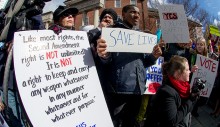Adrienne Harry
In June, Orlando, Florida claimed a grim title in the history books: it’s now the site of the deadliest mass shooting in American history. Yet, even in the face of tragedy, the debate over gun control in the United States becomes increasingly polarized. While political leaders seem to agree that mass shootings are unconscionable, legislators can’t seem to come up with clear, comprehensive ways to mitigate gun violence. What’s causing this deep divide?
Professor Ronald Pruessen, affiliated faculty at the Centre for the Study of the United States at the Munk School of Global Affairs, says that a growing political culture of playing on the public’s fears and prejudices is partly to blame. “Conservative and anti-state political views are deeply rooted in the United States and resisting gun control efforts has become a rallying cry for those holding such views in more recent years,” says Pruessen. “The strong current emphasis on the Second Amendment owes a great deal to political manipulation as well as the National Rifle Association’s significant campaign funding and programming. In a society where 40% of people don’t bother to vote, a staunch minority passionate about gun ownership can keep incumbents and aspiring voters extremely cautious about voting on Second Amendment issues.”
Past attempts to regulate civilian gun ownership in the U.S. have been met with challenges. The Brady Handgun Violence Prevention Act, which was signed into law in 1993, requires that individuals pass a criminal background check before purchasing a firearm. However, the law only covers federally licensed gun dealers, a deadly loophole which makes private gun sales, an estimated 40 per cent of gun purchases, exempt.
In 1994, the U.S. Congress passed a ten-year ban on assault weapons, outlawing the sale of certain semiautomatic firearms with two or more military-style features. While mass shootings in the U.S. saw a decline during the ten-year period – and for a few years after the ban expired – the ban was not retroactive to include semiautomatic firearms that had been purchased before the bill was signed. In addition, gun manufacturers responded to the ban by simply modifying the design of their weapons to comply with the law. The ban expired in 2004 and, in a post-911 climate of growing fear, was not renewed.
As the U.S. presidential election draws near, however, Pruessen sees a cocktail of factors that may tip the scale in favour of stricter, more comprehensive gun laws in America. “It’s a risky platform, but timing may be everything,” says Pruessen. “The Democrats and Hillary Clinton could conceivably pull it off in 2016 for three reasons. First, there may be a cumulative impact on voter sentiment by way of repeated mass shooting episodes since 2004. Second, the election may come close enough to the Orlando massacre to have an impact on both the presidential campaign and many House and Senate contests. Third, there may be enough disarray in the Republican Party, thanks to Donald Trump in particular, to tilt voters more heavily to the Democratic platform than would otherwise be the case. That’s a lot of stars to align, however...and the election is still four months away.”
July 11, 2016
